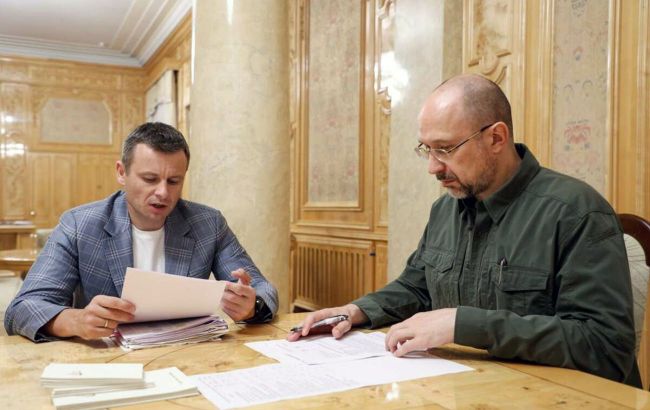Borrowing to survive: How Ukraine financing war and tackling multimillion debt
 Photo: The government is attracting billions of dollars in foreign aid to finance defense (CMU press center)
Photo: The government is attracting billions of dollars in foreign aid to finance defense (CMU press center)
Every year, Ukraine spends tens of billions of dollars to defend itself from Russia's full-scale invasion. The West does not provide funds for the army, but covers Ukraine's social needs. Which of the partners helps Ukraine the most, whether loans will be enough for 2026, and how to repay debts, read in RBC-Ukraine's article.
Key questions
- Where and how much aid does Ukraine receive from its partners?
- Who has provided the most free aid to Ukraine?
- How much money is there in 2025?
- Where will the state get funds for 2026?
- How does Ukraine plan to repay its debts?
Amount of foreign aid needed
Ukraine's finances since Russia's full-scale invasion are very different from those until 2022. While in 2020-2021, state budget expenditures exceeded revenues by only 10-15%, in 2022-2025, this figure was already 1.4-1.7 times higher. The state budget deficit in 2023-2024 exceeded UAH 1 trillion (USD 24 billion).
In 2021, defense spending accounted for 7-8% of all state budget expenditures. In 2022, this figure increased 6 times to 42%, and in subsequent years it amounted to 50% or more. That is, since the beginning of Russia's full-scale invasion, over half of the state budget has been spent on defense. In 2024-2025, this sector (the Ministry of Defense, the Security Service of Ukraine, the Ministry of Internal Affairs, etc.) received about UAH 2.2 trillion (USD 53 billion) annually.
"In terms of GDP, it's scary to realize that we spend 26% of GDP on the security and defense sector," Finance Minister of Ukraine Serhii Marchenko said at the end of 2024.
For comparison: Last year, the Baltic countries and Poland spent 3-4% of GDP on defense, Italy and Spain - 1.5% and 1.3% respectively, and most other EU countries - about 2%.
Russia, on the other hand, according to the Stockholm International Peace Research Institute, spent 7% of its GDP on war last year. In absolute terms, Moscow spends three times as much on warfare as Ukraine. In 2024, Russia's defense budget (including special services and the Ministry of Internal Affairs) amounted to USD 149 billion, while Ukraine's was USD 57 billion.
To cover the state budget deficit, Ukraine actively attracts external financial assistance from partners, which is provided in the form of free grants and loans. This assistance is roughly comparable to the size of the state budget deficit.
"Since the beginning of the full-scale war, almost all foreign aid (over 98%), whether in the form of soft loans or grants, has been directed to the state budget," ICU analysts add.
External financing is directed to the social sphere and the functioning of the state apparatus. At the same time, Ukraine covers defense spending on its own.
Financial balance in 2025
This year, the state budget deficit is expected to reach UAH 1.6 trillion or USD 39 billion (at the exchange rate of UAH 42 to the dollar). It is planned to be covered by foreign aid, the estimates of which differ greatly between the government and the National Bank.
In late April, Prime Minister of Ukraine Denys Shmyhal said that Ukraine would receive USD 39 billion from its partners. In late April, the National Bank released another Inflation Report, in which it predicted that in 2025, Ukraine could receive much more money, namely USD 55 billion.
According to the Ministry of Finance of Ukraine, in 2022-2025, Ukraine received the largest external revenues from the EU, the United States, the International Monetary Fund, and Japan.
Taras Marshalok, an analyst at the Kyiv School of Economics, estimates that in 2025, Ukraine will receive about USD 58 billion from external partners. The largest sources of external financing are the ERA loan program (USD 39.6 billion in 2025) and the Ukraine Facility program (USD 13.5 billion).
As part of the ERA Loans (Extraordinary Revenue Acceleration) instrument, Western partners agreed to use the funds received by European banks from frozen Russian assets for the needs of Ukraine. The total amount of assistance under this program is USD 50 billion.
The Ukraine Facility program is the EU's financial support for Ukraine, which is designed from 2024 to 2027, totaling USD 50 billion, most of which is transferred to the state budget. The share of other sources is less than 10%.
Money for next year
According to Denys Shmyhal, the main external sources of funding for 2026 are the same ERA, Ukraine Facility, and the IMF program. However, the government does not yet have a final vision of where to get all the necessary funds.
National Bank of Ukraine head Andrii Pyshnyi said that next year, Ukraine could receive only about USD 17 billion, and in 2027, even less - USD 15 billion. That is why the NBU expects to receive an amount this year that is significantly higher than the need to partially cover the 2026 expenditures.
Commenting on the sources of funds for 2026, the KSE believes that taxes should not be raised, domestic government bonds will remain an attractive investment instrument, and the IMF will continue to cooperate with Ukraine, despite delays in meeting the Fund's requirements. KSE analysts predict that if all the planned funds are received in 2025, there should be enough financial resources for the next year.
Confiscation of Russian assets in Europe
In addition to traditional sources, the government is discussing other possibilities, including the confiscation of frozen Russian assets in the EU. However, according to Dmytro Boiarchuk, the likelihood of such a scenario is low, as the EU fears the impact of confiscation on the stability of the euro.
Denys Shmyhal also mentioned such sources of funds in the future as the introduction of a special tax on trade with Russia, payment of reparations, and the introduction of a Marshall Plan for Ukraine. All these initiatives are still quite raw and require discussions with partners.
United States' role in financing Ukraine
In 2022-2024, the United States provided grant assistance to the state budget of USD 31.2 billion. The share of the United States in the total structure of grant aid to Ukraine in 2022-2024 was 66-94%, says Bohdan Slutskyi, an economist at the Center for Economic Strategy.
To finance Ukraine's needs in 2025-2026 under the ERA program, the Joe Biden administration transferred USD 20 billion to the World Bank's accounts. Of this amount, Ukraine received only USD 1 billion in December 2024, and the rest of the funds are expected to be disbursed in the future.
Funds under the ERA program are called conditional credit because they are repaid to creditors at the expense of the income received by European banks from frozen Russian assets, meaning that Ukraine does not pay for them.
In addition, Washington has provided Kyiv with several billion dollars worth of humanitarian aid, as well as military equipment and weapons (according to the US State Department) worth USD 66.5 billion. Thus, the following conclusions can be drawn about the US support for Ukraine during a full-scale war:
- The total value of the provided and reserved support is about $120 billion
- Ukraine received virtually all of the US assistance free of charge
- The United States remains the largest donor of grants to Ukraine.
Sky-high level of public debt
Attracting such large amounts of external financing has led to an increase in the state's debt to previously unprecedented levels - up to 100% of GDP. However, many of the wartime debts were obtained on preferential terms.
"The point is that we are not going to repay these debts in the next 30 years. Of course, we are talking about servicing, but the service rate is either preferential or partners decide to pay interest on debt obligations from their budgets. Therefore, I want to note that this debt is not a big burden at the moment," explained Serhii Marchenko.

